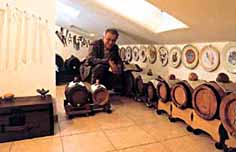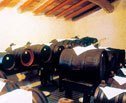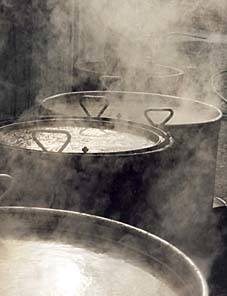Book author Rolf Merkle's first visit in July
Modena and surroundings. It's hot, very hot: 36 degrees. But it is said to be even hotter - in the Acetia, where the heat is oppressive and the air heavy. These are located directly under the usually uninsulated roof of houses.
In the attic it is not only very warm in summer - which is very good for the vinegar - it is also quite humid there (because the vinegar evaporates) and of course it smells of vinegar.
During this week I will visit around 10 Acetaien in and around Modena, try the vinegar from the barrels, talk to the vinegar winemakers and gain my first experience in tasting. I am very fortunate and honored to be able to attend a tasting that takes place once a year in Spilamberto.
On this evening 100 Aceto Balsamico Tradizionale (out of a total of 1000) will be tasted and evaluated. In this competition, all acetates - even those who only make ABTM for household use - can submit their vinegars and have them rated.
I'm sitting at the table of the Gran Maestro Assagiatore, Francesco Saccani. He is the undisputed master taster and expert in matters of ABTM. From him I learn to taste and evaluate the Aceto Balsamico Tradizionale.
It's like a wine tasting. First, the vinegar is assessed for its color, then for its fragrance and finally for its taste.
 Signor Saccani in his Acetaia
Signor Saccani in his Acetaia
In the next few days I will learn a lot more interesting things from Master Saccani and I will visit his Bonsai-Acetaia, as he affectionately calls his little Acetaia. He lives in Modena in a condominium.
The other residents' storage rooms are located under the roof. His family Acetaia is in one of these chambers - the door is secured with multiple locks. On perhaps 8 square meters there are some barrels, some of which are 100 years old, all filled with the precious liquid gold, the Aceto Balsamico Tradizionale. As the saying goes: there is space in the smallest hut.
At the end of the first week, I begin to understand what treasure I came across. In a time in which food is increasingly degenerating into industrial artifacts, denatured and artificially pimped up with aromas from the laboratory, in this time there is still a piece of earth on which a delicacy for us gourmets has been produced over years of work and over generations that is unique in its kind.
The second visit in July
It's hot again and it's muggy. This time of year is really not ideal for visiting the Acetia. Excellent conditions for the vinegar - just not for those who want to visit an Acetaia.
Again I visit ten Acetia. This time I also visit those who not only do an ABT, but also Aceto Balsamico di Modena. I am not thrilled. What I get to try there rarely deserves the name Aceto Balsamico. I find it damn difficult to get a good vinegar that has been made the traditional way - that is to say - with cooked must and stored in the barrel.

Aceto Balsamico Tradizionale Production pictured
I visit a small Acetaia that only has 2 batteries barrels and I visit some that have over 100 batteries. There are huge differences. Some Acetia are squeaky clean and all the kegs are lined up.
Others are rather dingy and dirty. With some Acetia I stay 2 to 3 hours, with others only 1 hour. That has to do with the fact that I try sometimes more, sometimes less.
There is Acetia, I sniff into every barrel and get a taste of it. With others - especially when they are dirty, I only do my compulsory programs.
 I can see that the best traditional balsamic vinegar is almost impossible to buy. They don't go on sale because there isn't enough of it or because the family keeps it for itself. What I can taste there is just great. My senses are infatuated and my taste buds do somersaults.
I can see that the best traditional balsamic vinegar is almost impossible to buy. They don't go on sale because there isn't enough of it or because the family keeps it for itself. What I can taste there is just great. My senses are infatuated and my taste buds do somersaults.
I would love to take one or two kegs under my arm and take home with me. But unfortunately that remains only a dream and so I shed one or two tears while enjoying these heavenly elixirs and already announce my next visit to try out "my" keg.
The third visit in September / October
Modena and Reggio Emilia. This time I spent a whole two weeks in the gourmet paradise. With a photographer I visited those Acetia that I wanted to present in detail in my book. And then I visited other Acetia in the province of Reggio Emilia , the second major center of the Aceto Balsamico Tradizionale, and of course I attended the Cottura, the boiling down of the grape must.
In the area around Reggio Emilia there are only a few Acetia that also sell their ABT. Only about 10 of them can make enough to sell. In general, there are relatively few Acetia compared to Modena and the surrounding area. While there are said to be around 15,000 families in and around Modena who do an ABT, there are only around 1,500 in and around Reggio Emilia.
The cottura
The freshly pressed grape must is poured into the caldaien, those containers in which the must is boiled down for hours. Some winemakers let their must simmer for 14 hours, others for up to 40 hours. At the end, about half of the grape must is left, which is filled into large glass containers that are left to rest until spring so that the must can clarify. The foam that forms in the Cottura is repeatedly skimmed off.

Cottura - the boiling down of the must













Aceto Balsamico Tradizionale
Matilde Piccinini, 136 pages
EUR (IT) 35,00
order now